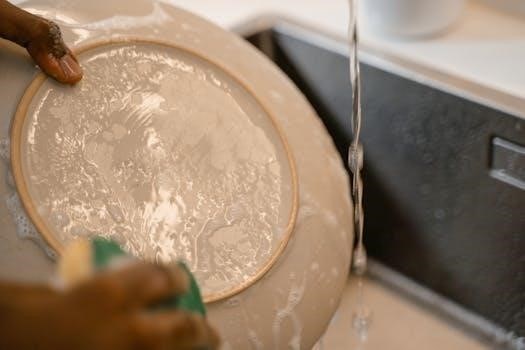
Sensus Water Meter Manual Overview
This manual provides a comprehensive guide to Sensus water meters, covering various models including the iPERL and OMNI series․ It details installation, operation, programming, and maintenance, ensuring proper usage and longevity of the devices․
Sensus water meters are advanced devices designed for accurate measurement of water consumption in various settings, from residential to industrial․ They utilize cutting-edge technologies like magnetic-drive and oscillating piston mechanisms, ensuring reliability and precision․ The meters are built to meet industry standards, such as American Water Works Association specifications, and are available in a range of sizes to accommodate diverse flow requirements․ Sensus offers models like the accuSTREAM, SR II, iPERL, and OMNI series, each with unique features tailored to specific applications․ These meters are constructed from durable, lead-free materials and include electronic registers with embedded AMI functionality, enabling remote data collection and analysis․ The iPERL system, for example, is designed for easy repair by water utilities, enhancing its cost-effectiveness․
Types of Sensus Water Meters
Sensus offers a variety of water meter types to meet diverse needs, including mechanical and electromagnetic options․ The mechanical meters, like the accuSTREAM and SR II, are magnetic-drive, positive-displacement, oscillating piston meters suitable for standard applications․ The iPERL series features an electronic register with advanced AMI functionality, enabling remote reading and leak detection․ The OMNI series employs Floating Ball Technology (FBT) for unrestricted flow and minimal wear․ Volumetric meters, such as the 620 and 640 families, are also part of Sensus’s offerings․ Additionally, Sensus provides electromagnetic flow meters for more demanding applications, with the accuSTREAM and SR II meeting AWWA standards․ Each type is designed for specific flow ranges and installation scenarios․ These meters are designed to be durable, with composite materials and lead-free construction, ensuring reliability and accuracy in various conditions․

Installation and Setup
Proper installation is crucial for accurate readings and meter longevity․ This section guides you through pre-installation checks, step-by-step procedures, and ensuring correct flow direction․ Follow these guidelines carefully․
Pre-Installation Checks and Preparation
Before installing your Sensus water meter, several critical checks and preparation steps are necessary to ensure a smooth and accurate setup․ First, verify that the meter is the correct size and type for your application, referring to the specifications provided in the manual․ Inspect the meter for any damage incurred during shipping, such as cracks or loose parts․ Ensure that all necessary tools and materials are readily available, including appropriate pipe fittings, sealant, and wrenches․ It’s essential to thoroughly flush the existing pipework to remove any debris or impurities that could damage the meter․ Confirm the direction of water flow in the pipeline and match it with the arrow on the meter body․ Finally, review local plumbing codes and regulations to ensure compliance․ These preliminary steps are vital for optimal performance and the longevity of your Sensus water meter․
Step-by-Step Installation Guide
Begin the installation process by carefully positioning the Sensus water meter in the designated location, ensuring the flow direction arrow on the meter aligns with the water flow in the pipe․ Connect the inlet side of the meter to the water supply line using appropriate fittings, making sure the connection is secure and leak-free․ Similarly, attach the outlet side of the meter to the downstream piping․ Gradually fill the pipeline with water, preventing any sudden surges that could harm the meter’s internal components․ Check all connections for leaks and tighten any loose fittings․ If the meter has a remote reading capability, ensure that the necessary wiring or connections are properly attached and secured․ Finally, document the initial meter reading and record the installation date․ These steps should be followed meticulously for accurate and reliable water measurement․
Verifying Proper Flow Direction
Confirming the correct flow direction is a crucial step in the installation of a Sensus water meter, ensuring accurate readings and preventing damage to the device․ The meter body is clearly marked with an arrow indicating the intended direction of water flow; this arrow must match the actual flow in your pipeline․ Before completing the installation, visually inspect the meter to verify that the arrow is pointing towards the direction the water is expected to travel․ Incorrect installation can lead to inaccurate meter readings and potentially cause internal damage, necessitating repairs or replacement․ Double-checking this alignment prior to finalizing the connections will help avoid such problems․ The arrow serves as a vital guide for proper installation, leading to accurate measurement and reliable service from the water meter․ Always check it before, during, and after installation․

Operation and Reading
This section explains how to operate your Sensus water meter and interpret the data displayed․ Understanding the meter’s readings is essential for monitoring water usage and identifying potential leaks․
Understanding the Meter Display
The Sensus water meter display is designed for easy reading, featuring a clear electronic screen․ Typically, it shows the current water consumption in a numerical format, often in cubic meters or gallons․ The display may also include additional indicators, such as flow direction, alarms, and diagnostic information, depending on the specific model․ Some meters, like the iPERL, have a fully electronic display with embedded AMI technology, offering enhanced data accessibility․ The display can be powered through the touch couple if the main power is lost, ensuring that last readings can be retrieved․ It is critical to familiarize yourself with these display elements to accurately monitor your water usage and identify any issues promptly․ The display ensures clear visibility, allowing for straightforward interpretation of consumption data․
Reading the Meter and Interpreting Data
Reading a Sensus water meter involves noting the numerical value displayed on the meter’s screen․ This value represents the cumulative water consumption since the meter was installed․ Depending on the model, the reading may be in cubic meters or gallons․ To interpret the data, compare the current reading with previous readings to determine the amount of water used over a specific period․ Some meters also provide additional data, such as flow rate, which can be helpful in understanding water usage patterns․ Additionally, understanding the various alarm indicators on the display is essential for detecting potential problems․ Note that the system reading can be reset via the touch-read connection․ Consistent monitoring and interpretation of the displayed data can help identify leaks or unusual usage, promoting efficient water management․

Programming and Configuration
Sensus water meters can be programmed and configured using specialized software, typically via a PC connection․ This allows for customization of parameters, alarm settings, and data logging preferences, enhancing meter functionality․
Connecting to a PC for Programming
To program Sensus water meters, a connection to a personal computer is typically required․ This process involves using specific hardware, such as the OMNI Communicator 100A, along with appropriate drivers installed on the PC․ The first step is to establish a physical connection between the meter and the PC using the designated communication device․ Once the hardware connection is secure, the user must then identify the correct COM port assigned to the communication device through the PC’s Device Manager․ This information is crucial for the software to recognize the connected meter․ With the correct COM port identified, the user proceeds to configure the connection settings within the programming software, selecting the accurate port to ensure successful data exchange․ This connection allows for parameter adjustments and software updates․ Remember to consult your Sensus representative for the necessary tools and software․
Using Unipro Software for Configuration
The Unipro software is essential for configuring Sensus water meters, enabling users to customize various parameters and settings․ Upon launching Unipro, users navigate to the ‘Defaults’ menu to adjust initial settings, where they select the specific meter model, such as iPERL․ This step opens a configuration interface, allowing users to modify system parameters, including alarm settings, reading modes, and customer identification․ The software provides options to utilize current settings, saved defaults, or input new values․ Users can then designate new default parameters or maintain existing configurations as per their preferences․ The user is prompted to set alarm masks and program specific parameters, choosing between current settings, default values or manually entering new values․ Unipro also enables saving report settings and logging data․ The interface is user friendly, guiding users through each step of the configuration process․ After completing the configuration, the changes are applied to the meter, enabling customized operation․

Maintenance and Troubleshooting
This section outlines essential maintenance procedures for Sensus water meters, including regular checks and cleaning․ It also offers guidance on identifying and resolving common issues, ensuring optimal performance and accuracy of the device․
Basic Maintenance Procedures
Regular maintenance is crucial for ensuring the longevity and accuracy of your Sensus water meter․ Begin by visually inspecting the meter for any signs of physical damage, such as cracks or leaks․ Check the connections and ensure they are secure and free from corrosion․ Periodically clean the meter housing with a damp cloth to remove dirt and debris, avoiding harsh chemicals that could damage the casing․ Ensure that the meter’s display is clear and easy to read․ It is also important to monitor for any unusual noises or vibrations during operation․ If you notice any irregularities, consult the troubleshooting section for further guidance․ Furthermore, make sure the area surrounding the meter is clear from obstructions, allowing for easy access for readings and maintenance․ These simple steps will help you keep your Sensus water meter in top condition․
Troubleshooting Common Issues
If you encounter problems with your Sensus water meter, several common issues can often be resolved․ First, if the meter display is not working, check the power source and connections․ A blank or flickering display may indicate a low battery or a connection problem․ If the meter is not registering flow, verify that the water is flowing in the correct direction as indicated by the arrow on the meter body․ Air pockets in the line can also cause inaccurate readings․ Ensure the line is flushed thoroughly to remove air․ If you suspect a leak, inspect all connections and pipework for any signs of water․ Incorrect programming can also cause problems; in this case, ensure that the meter is correctly configured according to the manual’s instructions․ If the issues continue, it might be necessary to contact a qualified technician for further assistance․